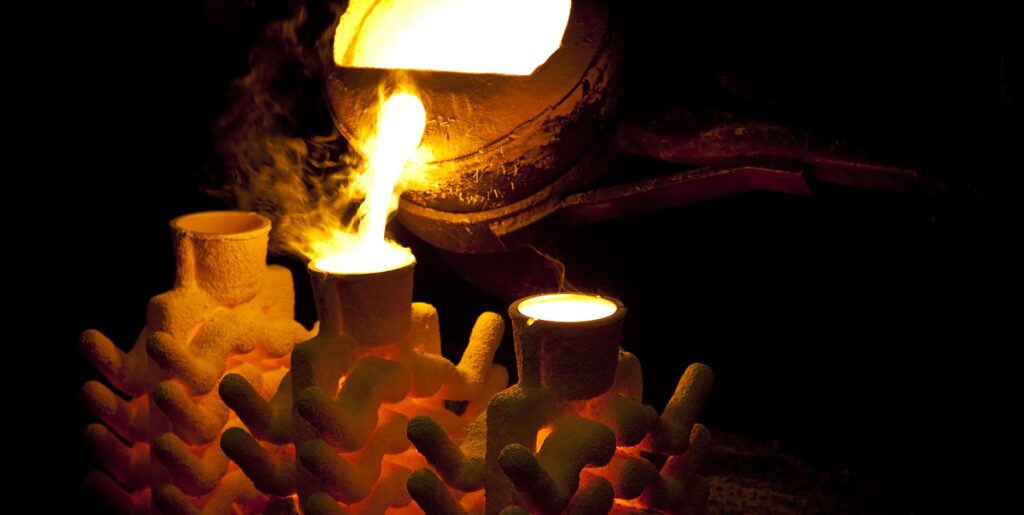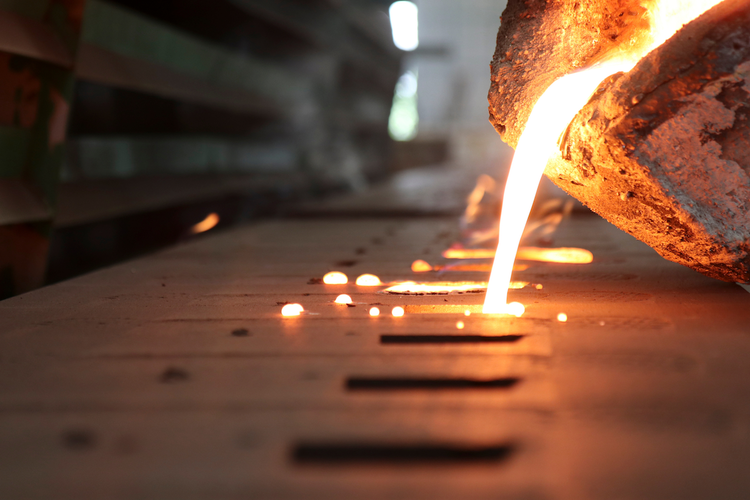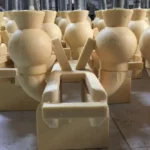Language:

Choosing the Right Casting Process: Sand casting vs. Investment Casting
In the intricate world of manufacturing and metalworking, the choice of the right casting process is pivotal to the success of a product. Two of the most prevalent and contrasting methods in this arena are investment casting and sand casting. Each method bears its unique set of characteristics, advantages, and applications, making them suitable for different manufacturing scenarios.
Investment casting, known for its precision and versatility, is a process where intricate shapes can be achieved with exceptional surface finish and dimensional accuracy. This method, often referred to as lost-wax casting, involves creating a detailed wax model of the desired metal part, which is then encased in a ceramic material to form a mould. Once the mould is heated, the wax melts away, leaving a cavity into which molten metal is poured to form the final casting.
On the other hand, sand casting, one of the oldest and most basic forms of casting, utilises a sand mixture to form moulds into which molten metal is poured. This method is renowned for its simplicity, adaptability, and ability to create large castings that might be challenging for other casting processes.
This article aims to delve into the nuances of these two casting processes, offering insights into their distinctions, benefits, and suitable applications. Understanding the differences between investment and sand casting is crucial for engineers, designers, and manufacturers to make informed decisions, ensuring the optimal method is chosen for producing high-quality, cost-effective components.
Table of Contents

Overview of Each Casting Process
Sand Casting
Sand casting is a process as old as metalworking itself, with roots stretching back thousands of years. It involves the creation of a sand-based mould into which molten metal is poured to form the desired shape. The sand used in this process is typically mixed with a binder to help it hold its shape. The main steps in sand casting include creating a pattern of the item to be cast, preparing the sand mould, melting and pouring the metal, and finally breaking away the sand mould to reveal the cast metal.
Key Characteristics of Sand Casting:
- Materials and Equipment: Commonly used materials include silica sand, clay, and water, mixed with binders. The equipment involved is relatively simple, often including moulding boxes, patterns, and a furnace for melting the metal.
- Flexibility in Size and Shape: Sand casting is particularly advantageous for casting large components and can accommodate a wide range of shapes and sizes.
- Surface Finish and Tolerances: This method typically results in a rougher surface finish and less precise tolerances compared to investment casting.
- Applications: It is widely used for casting various metals and alloys, particularly suitable for iron, steel, and non-ferrous metals, in industries ranging from automotive to heavy machinery.
Investment Casting
Investment casting, also known as precision casting or lost-wax casting, is lauded for its ability to produce components with exceptional accuracy, intricate details, and excellent surface finish. The process begins with creating a detailed wax model, often by injecting wax into a metal die. This model is then surrounded by a refractory ceramic material to form a mould. Once the mould is hardened, the wax is melted out, creating a cavity into which molten metal is poured.
Key Characteristics of Investment Casting:
- Materials and Equipment: This process typically uses wax for the pattern and various ceramic materials for the mould. Specialised equipment, including wax injection machines and kilns, is required.
- High Precision and Detail: Investment casting is known for achieving high dimensional accuracy and intricate detailing, allowing for the production of complex shapes.
- Surface Finish and Tolerances: It offers a superior surface finish and tighter tolerances compared to sand casting.
- Applications: Ideal for smaller castings and those requiring fine details, used across industries such as aerospace, medical, and jewellery.
Key Differences
1. Precision and Detail
- Investment Casting: Known for its exceptional precision, investment casting can produce components with intricate details and complex geometries. It is ideal for applications where tight tolerances and a high degree of dimensional accuracy are required.
- Sand Casting: While capable of producing a wide range of shapes and sizes, sand casting generally lacks the precision and detail found in investment casting. The resulting products often have a rougher surface and require additional finishing processes.
2. Material Waste and Sustainability
- Investment Casting: This process generates less waste material compared to sand casting, as the wax used for patterns can often be reclaimed and reused. However, the ceramic moulds are single-use, contributing to waste.
- Sand Casting: Although it produces more material waste due to the nature of the sand moulds, the sand can often be recycled and reused within the casting process, offering a degree of sustainability.
3. Cost Implications
- Investment Casting: Generally more expensive due to the materials used and the labour-intensive nature of the process, particularly for the creation and assembly of wax patterns.
- Sand Casting: More cost-effective, especially for larger volumes and larger parts, as the equipment and materials required are less expensive and the process is less labour-intensive.
4. Suitable Materials
- Investment Casting: Suitable for a wide range of metals, including both ferrous and non-ferrous alloys. It is particularly beneficial for casting metals with high melting temperatures.
- Sand Casting: Also versatile in terms of suitable materials, but it is especially favoured for larger castings made from metals like iron, steel, and non-ferrous alloys.
5. Production Volume and Efficiency
- Investment Casting: More suited for smaller production runs due to the complexity and time required for each casting.
- Sand Casting: Ideal for larger production volumes as the process is more straightforward and quicker, particularly for large components.
6. Surface Finish and Tolerances
- Investment Casting: Offers a superior surface finish and tighter tolerances right out of the mould, reducing the need for secondary finishing processes.
- Sand Casting: Typically results in a rougher surface finish and looser tolerances, often necessitating additional machining and finishing.
Advantages and Disadvantages
Investment Casting
Advantages:
- High Precision and Detail: Capable of producing parts with intricate details and complex shapes.
- Excellent Surface Finish: Typically provides a very smooth surface, reducing the need for secondary finishing.
- Versatility with Materials: Effective for a wide range of metals, including high-melting-point alloys.
- Minimal Waste: More efficient use of materials, with wax patterns being reusable.
Disadvantages:
- Higher Cost: Generally more expensive due to the labour-intensive process and cost of materials.
- Limited Part Size: Less suited for very large parts due to mould handling and wax pattern creation constraints.
- Longer Production Time: The process is more time-consuming, particularly for complex parts or high-quality finishes.
Sand Casting
Advantages:
- Cost-Effectiveness: More economical, especially for larger parts and higher production volumes.
- Flexibility in Size: Suitable for casting large components.
- Adaptability: Can use various types of metals and alloys.
- Simplicity of Process: Requires less specialised equipment and is easier to set up and operate.
Disadvantages:
- Lower Precision and Detail: Not suitable for parts requiring intricate details or tight tolerances.
- Rougher Surface Finish: Often requires additional machining and finishing.
- Potential for Material Waste: Though sand can often be recycled, there is still a higher waste potential compared to investment casting.

Which One Should You Choose?
The decision between investment casting and sand casting hinges on several key factors related to your project requirements. Here are some guidelines to help you make an informed choice:
Consider Investment Casting When:
- Precision is Paramount: If your project demands high dimensional accuracy and intricate details, investment casting is the preferred choice.
- Complex Geometries: For parts with complex shapes, undercuts, or internal structures, investment casting can handle such specifications with ease.
- Superior Surface Finish: If the end product requires a smooth finish right out of the mould, thereby minimising secondary processing, investment casting is ideal.
- Small to Medium Size Parts: It is particularly effective for smaller components where precision and detail are crucial.
Opt for Sand Casting When:
- Cost-Effectiveness is a Priority: For projects with budget constraints, sand casting is generally more economical, especially for larger volumes.
- Large Parts Production: If you are manufacturing large or very heavy parts, sand casting is better suited due to its scalability and flexibility in handling larger moulds.
- Shorter Lead Times: When production time is a critical factor, sand casting can offer quicker turnaround times, especially for simpler designs.
- Material Versatility: If you’re working with a wide range of metals and alloys, particularly those that are suitable for high-temperature applications, sand casting provides the necessary flexibility.
Project-Specific Considerations:
- Production Volume: For small-scale or limited production runs, investment casting might be more feasible, whereas sand casting is more efficient for larger-scale production.
- Material and Finish Requirements: Assess the material specifications and the desired finish of the final product. Investment casting is better for complex alloys and high-quality finishes, while sand casting is suitable for more robust and less intricate designs.
Conclusion
In navigating the intricate world of metal casting, the choice between investment casting and sand casting is dictated not just by the inherent qualities of these processes but also by the expertise and capabilities of the casting provider. Taiyuan Simis Investment Casting Co., Ltd stands as a testament to excellence in both these casting techniques, offering a breadth of services tailored to meet diverse project requirements.
With a robust portfolio in investment casting, Simis excels in producing high-precision, detailed components. The company’s state-of-the-art facilities and skilled workforce adeptly handle complex geometries and fine finishes, making it an ideal partner for projects where accuracy and aesthetic appeal are crucial. This proficiency in investment casting positions Simis as a leader in creating components for industries where meticulous detail and high-grade finishes are non-negotiable.
Concurrently, Taiyuan Simis Investment Casting Co., Ltd also demonstrates exceptional expertise in sand casting. With advanced technology, including advanced sand casting production lines such as the Disamatic line, and a deep understanding of this traditional casting method, Simis can efficiently manage large-scale productions, particularly those involving large or heavy parts. These fully integrated production lines enhance the company’s capacity for handling high-volume projects with precision and speed.
The company’s ability to work with a variety of metals and alloys, coupled with its cost-effective production approach, makes it a preferred choice for projects where scale, versatility, and economy are key considerations. The integration of sophisticated sand casting lines further reinforces Simis’s position as a leader in the foundry industry, adept at meeting diverse and complex project requirements with unmatched efficiency and quality.
In essence, whether your project demands the precision and intricate detailing afforded by investment casting, or the robustness and scalability of sand casting, Simis Investment Casting Co., Ltd is equipped to deliver with excellence. Their comprehensive understanding of both processes, combined with a commitment to quality and customer satisfaction, ensures that every project is executed with the utmost proficiency, aligning with the client’s specific requirements.
Thus, when selecting a casting process for your next project, consider not only the technical aspects but also the expertise of your casting partner. With Simis Investment Casting Co., Ltd, you gain access to a wealth of knowledge and experience in both investment and sand casting, ensuring that your final product is not just a component, but a masterpiece of engineering and craftsmanship.



